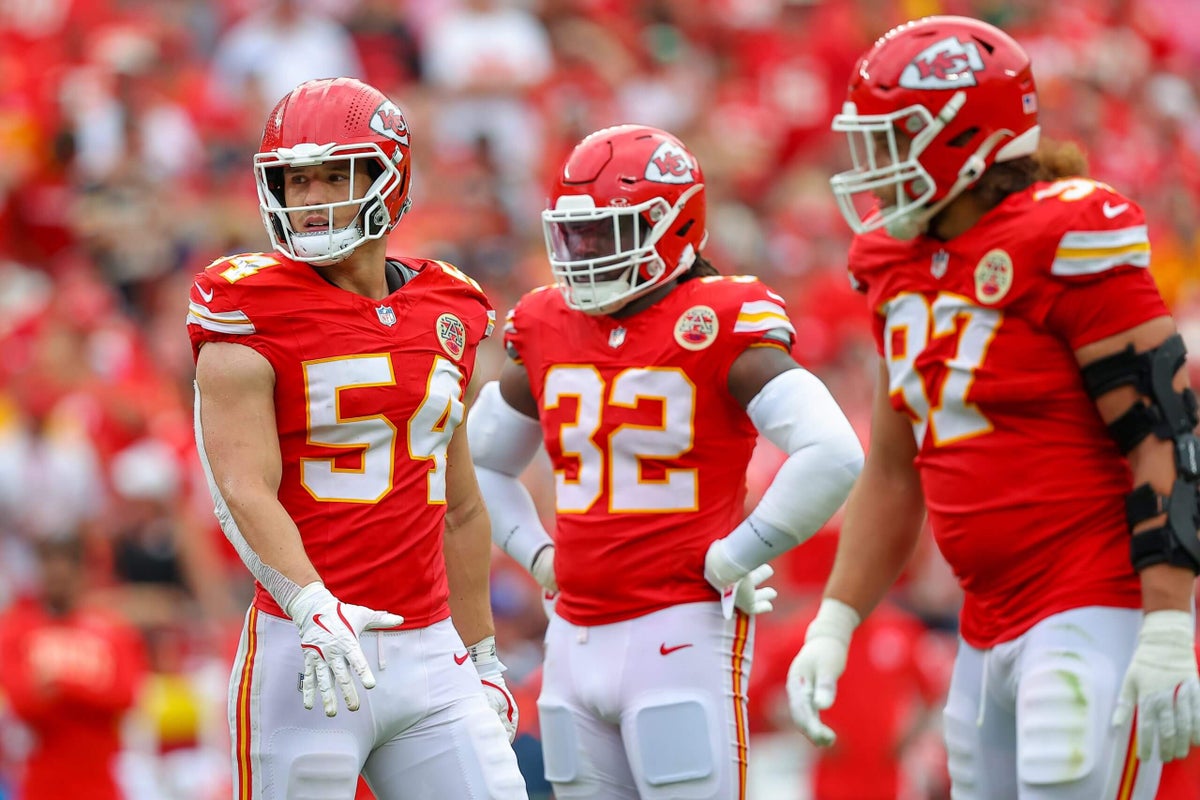KANSAS CITY, Mo. — Kansas City Chiefs linebacker Leo Chenal is confident that his team’s defense is different from a month ago.
And notably — given this week’s matchup against the Detroit Lions — he believes the Chiefs’ defense is better equipped to handle a play-action-heavy team than it was in the opener against the Los Angeles Chargers.
That Week 1 game, when Chargers quarterback Justin Herbert threw for 318 yards and three touchdowns in his team’s 27-21 victory? It was rough for the Chiefs’ defense.
Notably, Herbert finished 9 of 11 for 169 yards on play-action, according to NFL Next Gen Stats, and also was 11 of 13 for 187 yards with two touchdowns when targeting in-breaking routes.
“The first game … obviously, we want to be perfect. But I think our eyes have gotten better,” Chenal said Friday after practice. “Because all that is (play-action) is about eyes.”
Let’s start with some numbers. If the 2-3 Chiefs hope to reroute the trajectory of their season with a win on “Sunday Night Football,” they’ll need to be most concerned with the Lions’ offensive deception.
The reason? This is about as big a “strength-versus-weakness” matchup as you’ll find in an NFL game this season.
According to SumerSports, the Lions run the 11th-highest percentage of play-action, and they’re deadly when they do. They average 0.64 expected points added per play-action pass attempt, the top mark in the NFL.
The Chiefs’ defense, to counter, has allowed 0.80 EPA per play-action pass — last in the NFL.
“They’re really good at play-action,” Chiefs defensive coordinator Steve Spagnuolo said of the Lions. “In other words, they sell it.”
Part of that is by formation. The Lions don’t just preach the importance of running the football; they often follow through by putting themselves in a ground-game-friendly setup.
Detroit has gone under center for 55 percent of its offensive plays this season, per SumerSports, the highest mark in the NFL. That structure can provide greater directional freedom, with each snap able to easily open up runs to either side.
And it brings up another problem area for the Chiefs. The Lions are sixth in EPA per play when under center, while the Chiefs are last in the NFL when defending under-center plays.
It shouldn’t have taken the Lions much time — or film — to see a potential vulnerability to attack against the Chiefs.
But going back to play-action … why are the Lions so good at it? And what can the Chiefs do to limit big plays there?
Spagnuolo said it goes back to the Lions’ offensive system. He complimented the team’s coaches for doing an excellent job of “marrying” their runs and passes.
Think of it like this: The Lions will have a run play with a specific formation and motion. Then, later on, they will have that same formation and motion … only this time, a pass will come from that same setup.
All that makes it difficult for the Chiefs to key in on “tells” that might give away a run or pass before it happens.
It even extends to this: Spagnuolo said his defensive assistant coaches will keep track of the Lions’ run plays on the sideline during the game. Then, during breaks, they’ll warn Chiefs defenders to be ready for a pass that could come later, believing it’s only a matter of time until the Lions follow their first rush with a counterpunch from their offensive play sheet.
“Hopefully we can be ahead of the game on those,” Spagnuolo said.
Chenal said one of the biggest factors would be a two-word key that Spagnuolo preaches often: “eye discipline.”
Though the Lions’ offensive linemen do an excellent job of selling run on play-action passes, there’s still a subtle difference to note early between run blocking and pass blocking. Specifically, it goes back to looking for an old football term: “high hat,” which is code for seeing the offensive linemen’s helmets bob upward after the snap of the ball.
That motion, even if abbreviated, is an indicator that an O-lineman is getting his body ready to absorb the blow of a pass rusher on a potential throw.
Other attributes make the Lions’ offense difficult to stop, too. Chenal noted that the Lions have playmakers across the field, including speedy receivers on the outside and running backs who must be respected in the ground game.
It will be a lot for the Chiefs to handle. The Lions are No. 1 in the NFL in EPA per dropback this season, and they’ve also feasted on teams that commit too many resources toward stopping their rushing attack.
“Any time a team can be on schedule from an offensive standpoint and be a threat to us, run or pass,” Spagnuolo said, “it’s going to be a challenge.”

